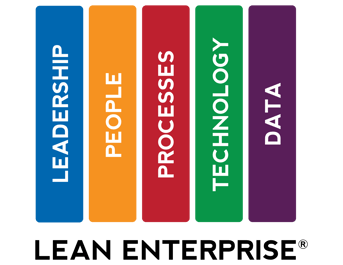“Tribal knowledge is any unwritten information that is not commonly known by others within a company. This term is used most when referencing information that may need to be known by others to produce a quality product or service.”
What is Business Tribal Knowledge?
Many companies have long-term employees who, over years and years of service to that company, have accumulated tribal knowledge that often departs with them when they either leave to work elsewhere or retire. That can be devastating to a company’s ability to continue to keep engineering and manufacturing processes intact when undocumented information vital to those processes leaves with a departed employee. Tribal knowledge is associated with the Engineering Intelligence pillar of the Lean Engineering Maturity Model but is directly affected by the People Pillar while having an extreme impact on the Processes pillar. “The Lean Engineering Maturity Model” can be best defined and depicted by 5 pillars that make up the Model. This model helps a company calculate value and performance of engineering assets in 5 key areas along with how they align with company/corporate objectives.

In many industries, a good deal of the knowledge about products, processes and customers is not written down—it is in the workers' heads. It is not only more important than most corporations will admit but is also a driving force behind innovation; it is critical to the company's competitive advantage; and is vital to the continuance of existing design and manufacturing processes. It can also be important in the training of a retiree's replacement.
Tribal knowledge can exist in different forms ranging from stored head-knowledge to personal documents or other non-shared forms such as personally authored applications, CAD symbols, processes, scripted procedures, etc. The objective is to "download" the information from the gurus' brain & private records, and document it before it walks out the door in the possession of a long-time employee headed to “greener pastures” or with a retiring individual.
How Does Concealed Tribal Knowledge Happen?
There are two reasons by which tribal knowledge comes into existence within an enterprise. The first reason can be that an individual employee chooses for personal reasons to keep knowledge he has acquired or created to themselves. The second reason is that accumulated tribal knowledge can often be a failure on the part of company leadership to manage the creation and protection of intellectual property.
Years ago, I received a call from a company president alerting me that he wished to move his companies engineering processes toward the use of 3D models while changing their form of document control to a digital method. Upon hearing his stated desire, I offered to meet with him to gain a better understanding of what that transformation would look like for him and when he wanted to begin the process. He then told me that he couldn’t begin the process until his CAD Manager had retired because this individual refused to preside over such a change in methods and threatened to leave if forced to do so. The President knew that his CAD Manager wheeled much power by virtue of the vast amount of “tribal knowledge” he possessed, so the president was forced to “bide his time” until he had gleaned as much of the undocumented information from this individual as possible over his final year at the company. In this case, it delayed the very important transformation of the owner’s company while putting him further behind his competition who had already made similar changes.
There are many reasons why an employee might accumulate undocumented knowledge; those reasons can be many and not limited to the following examples.
- There are those employees that determine that, if they can rat-hole enough knowledge about processes, customers, or methodologies, they can effectively insulate themselves from termination.
- Some employees will hide accumulated intellectual property in an attempt to elevate their status or corporate persona and create the illusion that they are more vital to the company because they can potentially address problems or issues that no one else can because of their secret stash of information.
- Some employees, out of a sense of laziness or because they don’t like to use prescribed forms of documentation, will simply refuse to follow company protocols for document management.
- Ultimately, there may be those that will avoid personal adoption of new document management systems or methods because it could potentially reveal the bevy of tribal knowledge they have amassed and concealed through the years.
Reasons why corporate Level management may overlook or be unaware of the problem of Tribal Knowledge.
Since many of those in management are simply unaware of the methods available to capture this knowledge and make it available, many companies suffer from the unseen presence of much tribal knowledge due to the departure of a long-time employee. Often management is not aware of the many pockets of tribal knowledge, so they do not understand the risk to overall operations and profitability.
- Sometimes tribal knowledge is erroneous and because it is not documented, it’s not subject to scrutiny by anyone other than the person who created and holds that information.
- When a long-term employee leaves the company because they move to another job outside the company or retire, their collected tribal knowledge can be lost forever.
Senior management may fail to recognize the organization's stage in the normal business lifecycle. For example, start-ups are run almost completely on the tribal knowledge of the founders and the inner circle. That works well for a time, but if a startup tries to expand too quickly without documenting its process knowledge and using knowledge transfer best practices, it will struggle. Some businesses have had a low turnover for many years and are facing a tsunami of retirements. If they have never formalized their business workflows, much of their tribal knowledge will vanish within the next 2-3 years. (By Joanne Wortman Posted January 19, 2017) Discovery and Retention of Tribal Knowledge
So how do we discover, quantify, and capture tribal knowledge vital to the long-term health and effectiveness of a company before it leaves with those who possess it? This question is worthy of consideration and we at D3 Technologies will engage with you to discover if this issue is one that puts your company at risk.
For more information on how to capture and retain your valuable “Tribal Knowledge” contact us at D3 Technologies. -Stan Suttles
“Stan Suttles is an industry professional with over 35 years’ of experience in providing high level specialized solutions to companies in the manufacturing community who are looking to improve their engineering, collaborative and workflow processes.”
Do you use any of these tips and tricks in your daily workflow? Feel free to brag about your success in the comments!
Like what you’ve read? Subscribe to our blog!
Feel free to share on Twitter or Facebook!



